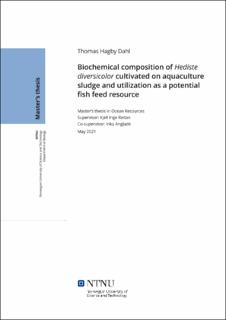| dc.contributor.advisor | Reitan, Kjell Inge | |
| dc.contributor.advisor | | |
| dc.contributor.advisor | Anglade, Inka | |
| dc.contributor.author | Dahl, Thomas Hagby | |
| dc.date.accessioned | 2021-10-05T17:38:52Z | |
| dc.date.available | 2021-10-05T17:38:52Z | |
| dc.date.issued | 2021 | |
| dc.identifier | no.ntnu:inspera:79422864:15885679 | |
| dc.identifier.uri | https://hdl.handle.net/11250/2787911 | |
| dc.description.abstract | Kultiveringen av atlantisk laks (Salmo salmar) er helt avhengig av marine ressurser av høy kvalitet som fiskemel og fiskeolje. Begrensinger på tilgangen til disse ressursene tvinger industrien til å utnytte alternative fôrressurser for å opprettholde bærekraftig vekst og utvikling. Det har kommet en oppfordring fra forskningsrådet (RCN) om å utvikle nye kultiveringsmetoder for lavtrofiske arter til benyttelse som fremtidige fôrressurser.
Målet med denne oppgaven var å evaluere potensialet til børstemarken Hediste diversicolor, som utelukkede er fôret på slam fra akvakulturnæringen, som en alternativ fôrressurs i fiskefôr. Hovedmålene var å vurdere egnetheten til smolt og postsmolt slam som diet for H. diversicolor, bestemme graden av innflytelse av ulike fôrnivåer på vekst og den biokjemiske sammensetningen, og utrede potensialet til H. diversicolor som en alternativ fôrressurs.
Børstemarkene ble hentet fra flere strender langs Trondheimsfjorden og kultivert i et laboratorium ved SINTEF Ocean på smolt- og postsmolt slam. Effekten av ulike mengder av de to slammene på H. diversicolor med hensyn på vekst, overlevelse og biokjemisk sammensetning ble evaluert.
Resultatene viste at både smolt- og postsmolt slam var like effektive med hensyn på vekst og overlevelse. Økt fôring resulterte i korresponderende økt vekst. Resultatene viste ingen signifikante forskjeller i innholdet av protein, aminosyrer, mineraler eller vitaminer i noen av børstemarkene. Det ble derimot observert signifikante forskjeller i totallipidinnholdet mellom de ulike fôringsnivåene, og mellom fôringsnivåene og kontrollgruppen. Effekten av slam på totallipidinnholdet var størst i postsmolt-gruppene.
Økt fôring resulterte også i økende nivåer av essensielle omega-3 og omega-6 fettsyrer i de ulike gruppene, noe som beskriver evnen H. diversicolor har til å utnytte og inkorporere verdifulle, gjenværende næringsstoffer i slam fra akvakulturnæringen som ellers ville gått tapt til miljøet. Børstemarkene inneholdt høye og tilstrekkelige nivåer av essensielle aminosyrer, fettsyrer, proteiner, lipider, mineraler og spornivåer av flere essensielle vitaminer i forhold til næringsbehovet til Salmo salmar. Resultatene viser at H. diversicolor fôret på slam fra akvakulturnæringen har potensiale til å bli en bærekraftig alternativ fôrressurs i fremtidig fiskefôr, og mulig erstatte andeler av andre verdifulle ressurser som fiskemel og fiskeolje. | |
| dc.description.abstract | Cultivation of Atlantic salmon (Salmo salmar) is entirely dependent on high quality feed resources such as fishmeal and fish oil. Limitations of the availability of these resources forces the industry to look elsewhere for alternative feed resources to maintain growth and development in a sustainable manner. A proposal from the Research Council of Norway (RCN) calls for production of marine species from low-trophic levels with feed potential, as a response to this issue.
The aim of this thesis was to evaluate the potential of the polychaete Hediste diversicolor fed on aquaculture sludge as an alternative feed resource for fish feed. The main objectives were to evaluate the suitability of smolt and post-smolt sludge as diets for H. diversicolor, determine the influence of different feeding levels on growth and biochemical composition, and establish the potential of H. diversicolor as an alternative feed resource.
Wild polychaetes were collected from beaches in Trondheimsfjorden and cultivated in a laboratory at SINTEF Ocean on smolt and post-smolt sludge. The effects of the different sludges and feeding levels in terms of growth, survival and biochemical composition were evaluated.
The results showed that polychaetes had equally successful growth and survival rates when fed on both sludges as a sole food source. Increased amounts of sludge given to the polychaetes correlated with increased growth rate. The results showed no significant changes in protein, amino acids, minerals or vitamins contents of the polychaetes fed on the two types of aquaculture sludges. Significant differences in relative content of total lipid were found within the treatments and compared to the initial polychaetes. The effect of post-smolt sludge was greater compared to smolt sludge in terms of total lipid.
Increased levels of feed given to the polychaetes also resulted in increased levels of essential omega-3 and omega-6 fatty acids in the different treatment groups, providing proof of the ability of H. diversicolor to utilize and incorporate valuable excessive nutrients in aquaculture sludge that otherwise would have been lost into the environment. Polychaetes contained high and adequate levels of essential amino acids, fatty acids, proteins, lipids, minerals, and trace levels of several essential vitamins regarding the nutritional requirements of Salmo salmar. Thus, H. diversicolor fed on aquaculture sludge displays potential to become a sustainable alternative feed resource in future fish feed, potentially replacing parts of other highly valued marine resources such as fishmeal and fish oil. | |
| dc.language | | |
| dc.publisher | NTNU | |
| dc.title | Biochemical composition of Hediste diversicolor cultivated on aquaculture sludge and utilization as a potential fish feed resource | |
| dc.type | Master thesis | |
